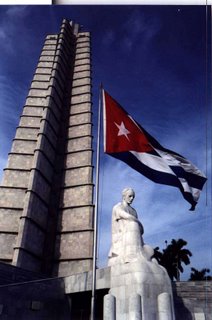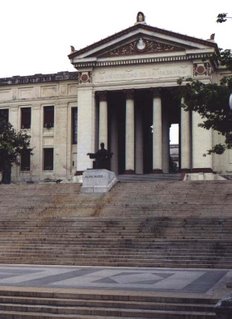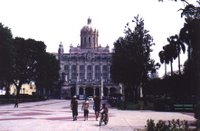2004 Cuba – Part 1, Havana

My husband and I chose to travel to the capital of Cuba instead of doing the resort thing. We were interested in learning as much as we could about Cuban history and the Revolution, and weren’t interested in indulging some lazy fantasy of sitting on a beach all day. So, we thought that Havana was a good place to start. My parents also joined us on this trip, and we all had a good time. We spent a lot of time walking around and going to museums and markets. It was a beautiful experience, and even though we were only there for a short period of time we did learn a lot.

The old Spanish architecture is beautiful – there are marble floors everywhere, and beautiful balconies and windows. The Cubans are trying hard to restore these old buildings, but unfortunately it is a constant battle with the sea salt and coastal weather which is not conducive to preservation of buildings.
The Universidad de la Habana is a gorgeous old building. This university was established in 1728, making it one of the oldest universities in the Americas. Cubans are extremely well educated people, with 97% literacy rates. Education, including post secondary education, is free.
 Fidel Castro was very much involved with public affairs still at that time, and was speaking at (mandatory attendance) rallies both the day before we arrived and the day after we left. There are political slogans on murals and billboards all throughout Havana. It is really interesting. There are also monuments of the revolution and revolutionaries prominently displayed throughout the city.
Fidel Castro was very much involved with public affairs still at that time, and was speaking at (mandatory attendance) rallies both the day before we arrived and the day after we left. There are political slogans on murals and billboards all throughout Havana. It is really interesting. There are also monuments of the revolution and revolutionaries prominently displayed throughout the city.

The Museo de la Revolution did a great job of accounting the history of Cuba from the time of colonization to the present day, including a significant section on the Revolution. The Museo is appropriately located in Batista’s Presidential Palace (an amazingly opulent structure).

Another historical point of interest that we visited was the Fortaleza de San Carlos de la Cabana. This is one of the many forts that was built by the Spanish in 1700s. It was huge, and amazing from an architectural and functional standpoint. More recently it was where Che Guevara set up headquarters in the first months following the Revoluntion in 1959.
There are soldiers on literally every street corner. They stand around, and joke with the public, and generally seem to keep the peace. We didn’t see any altercations. But from what I understand, there is a definite Big Brother thing going on, where any suspicious activities are noted and passed on to the government. Although this seems to make things flow smoothly, I am sure that there are strong undercurrents of discontent at the same time.

My husband and I chose to travel to the capital of Cuba instead of doing the resort thing. We were interested in learning as much as we could about Cuban history and the Revolution, and weren’t interested in indulging some lazy fantasy of sitting on a beach all day. So, we thought that Havana was a good place to start. My parents also joined us on this trip, and we all had a good time. We spent a lot of time walking around and going to museums and markets. It was a beautiful experience, and even though we were only there for a short period of time we did learn a lot.

The old Spanish architecture is beautiful – there are marble floors everywhere, and beautiful balconies and windows. The Cubans are trying hard to restore these old buildings, but unfortunately it is a constant battle with the sea salt and coastal weather which is not conducive to preservation of buildings.
The Universidad de la Habana is a gorgeous old building. This university was established in 1728, making it one of the oldest universities in the Americas. Cubans are extremely well educated people, with 97% literacy rates. Education, including post secondary education, is free.
 Fidel Castro was very much involved with public affairs still at that time, and was speaking at (mandatory attendance) rallies both the day before we arrived and the day after we left. There are political slogans on murals and billboards all throughout Havana. It is really interesting. There are also monuments of the revolution and revolutionaries prominently displayed throughout the city.
Fidel Castro was very much involved with public affairs still at that time, and was speaking at (mandatory attendance) rallies both the day before we arrived and the day after we left. There are political slogans on murals and billboards all throughout Havana. It is really interesting. There are also monuments of the revolution and revolutionaries prominently displayed throughout the city.
The Museo de la Revolution did a great job of accounting the history of Cuba from the time of colonization to the present day, including a significant section on the Revolution. The Museo is appropriately located in Batista’s Presidential Palace (an amazingly opulent structure).

Another historical point of interest that we visited was the Fortaleza de San Carlos de la Cabana. This is one of the many forts that was built by the Spanish in 1700s. It was huge, and amazing from an architectural and functional standpoint. More recently it was where Che Guevara set up headquarters in the first months following the Revoluntion in 1959.
There are soldiers on literally every street corner. They stand around, and joke with the public, and generally seem to keep the peace. We didn’t see any altercations. But from what I understand, there is a definite Big Brother thing going on, where any suspicious activities are noted and passed on to the government. Although this seems to make things flow smoothly, I am sure that there are strong undercurrents of discontent at the same time.

0 Comments:
Post a Comment
<< Home